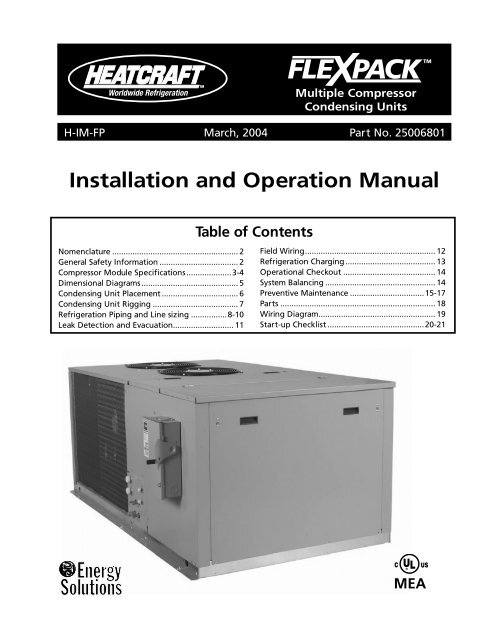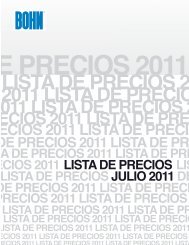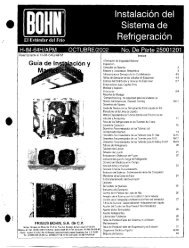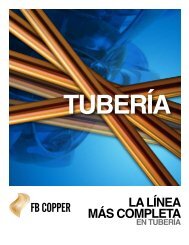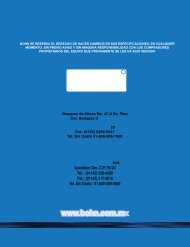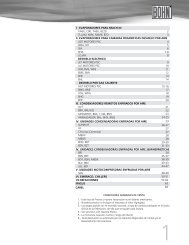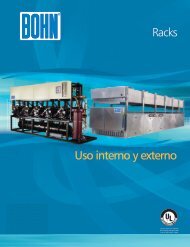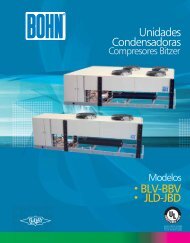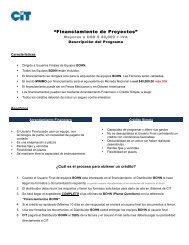Installation and Operation Manual - Bohn
Installation and Operation Manual - Bohn
Installation and Operation Manual - Bohn
Create successful ePaper yourself
Turn your PDF publications into a flip-book with our unique Google optimized e-Paper software.
Multiple CompressorCondensing UnitsH-IM-FP March, 2004 Part No. 25006801<strong>Installation</strong> <strong>and</strong> <strong>Operation</strong> <strong>Manual</strong>Nomenclature ........................................................ 2General Safety Information ................................... 2Compressor Module Specifications ....................3-4Dimensional Diagrams ........................................... 5Condensing Unit Placement .................................. 6Condensing Unit Rigging ...................................... 7Refrigeration Piping <strong>and</strong> Line sizing ................8-10Leak Detection <strong>and</strong> Evacuation ........................... 11Table of ContentsField Wiring .......................................................... 12Refrigeration Charging ........................................ 13<strong>Operation</strong>al Checkout ......................................... 14System Balancing ................................................. 14Preventive Maintenance .................................15-17Parts ..................................................................... 18Wiring Diagram .................................................... 19Start-up Checklist ...........................................20-21TMMEA
NomenclatureTPC1 - One Condenser Fan CabinetTPC2 - Two Condenser Fan CabinetTPC3 - Three Condenser Fan CabinetGeneral Safety InformationGeneral Safety Information1. <strong>Installation</strong> <strong>and</strong> maintenance to be performed only by certified personnel who are familiar with thistype of equipment.2. Make sure that all field wiring conforms to the requirements of the equipment <strong>and</strong> all applicablenational <strong>and</strong> local codes.3. Avoid contact with sharp edges <strong>and</strong> coil surfaces. They are a potential injury hazard.4. Make sure all power sources are disconnected before any service work is done on units.InspectionResponsibility should be assigned to a dependable individual at the job site to receive material. Eachshipment should be carefully checked against the bill of lading. The shipping receipt should not be signeduntil all items listed on the bill of lading have been accounted for. Check carefully for concealed damage.Any shortage or damages should be reported to the delivering carrier. Damaged material becomes thedelivering carrier’s responsibility <strong>and</strong> should not be returned to the manufacturer unless prior approval isgiven to do so. When uncrating, care should be taken to prevent damage. Heavy equipment should beleft on its shipping base until it has been moved to the final location.© 2004, Heatcraft Refrigeration Products LLC2
Compressor Module SpecificationsTable 2. Scroll Compressor Module Electrical DataMedium Temp.Low Temp.HP222 1/22 1/2333 1/23 1/24 1/24 1/25 1/25 1/26222 1/22 1/2333 1/23 1/24 1/24 1/25 1/25 1/26Scroll Compressor Compressor Data CrankcaseCompressor Electrical Rating RLA = MCC/1.56 Heater Refrigerant Evap. Temp.Model Volts Phase Hz RLA LRA MCC Watts Type Lbs. Min. MaxZS15K4E-PFV 208-230 1 60 12.2 61.0 19.0 40 404a 22 -5 35ZS15K4E-TF5 208-230 3 60 8.3 55.0 13.0 40 404a 22 -5 35ZS19K4E-PFV 208-230 1 60 14.7 73.0 23.0 40 404a 22 -5 35ZS19K4E-TF5 208-230 3 60 8.7 63.0 13.6 40 404a 22 -5 35ZS21K4E-PFV 208-230 1 60 14.7 88.0 23.0 80 404a 22 -5 35ZS21K4E-TF5 208-230 3 60 9.9 77.0 15.5 80 404a 22 -5 35ZS26K4E-PFV 208-230 1 60 18.6 109.0 29.0 80 404a 22 -5 35ZS26K4E-TF5 208-230 3 60 12.2 88.0 19.0 80 404a 22 -5 35ZS30K4E-PFV 208-230 1 60 24.0 129.0 37.5 80 404a 22 -5 35ZS30K4E-TF5 208-230 3 60 13.5 99.0 21.0 80 404a 22 -5 35ZS38K4E-PFV 208-230 1 60 28.8 169.0 45.0 80 404a 22 -5 35ZS38K4E-TF5 208-230 3 60 19.2 123.0 30.0 80 404a 22 -5 35ZS45K4E-TF5 208-230 3 60 21.5 156.0 33.5 80 404a 22 -5 35ZF06K4E-PFV 208-230 1 60 12.2 61.0 19.0 40 404a 22 -40 0ZF06K4E-TF5 208-230 3 60 8.3 55.0 13.0 40 404A 22 -40 0ZF08K4E-PFV 208-230 1 60 14.7 73.0 23.0 40 404a 22 -40 0ZF08K4E-TF5 208-230 3 60 8.7 63.0 13.6 40 404a 22 -40 0ZF09K4E-PFV 208-230 1 60 12.8 88.0 20.0 80 404a 22 -40 0ZF09K4E-TF5 208-230 3 60 8.7 77.0 13.5 80 404a 22 -40 0ZF11K4E-PFV 208-230 1 60 16.0 109.0 25.0 80 404a 22 -40 0ZF11K4E-TF5 208-230 3 60 10.9 88.0 17.0 80 404a 22 -40 0ZF13K4E-PFV 208-230 1 60 22.4 129.0 35.0 80 404a 22 -40 0ZF13K4E-TF5 208-230 3 60 11.9 99.0 18.5 80 404a 22 -40 0ZF15K4E-PFV 208-230 1 60 25.0 169.0 39.0 80 404a 22 -40 0ZF15K4E-TF5 208-230 3 60 17.0 123.0 26.5 80 404a 22 -40 0ZF18K4E-TF5 208-230 3 60 19.6 156.0 30.5 80 404a 22 -40 04
Dimensional DiagramsFigure 1.One Fan Top ViewOptional Disconnect SwitchEnd ViewSystem Position3 2 1Please note system positions.Electrical Knockout (4)Liquid LinesSuction LinesTwo Fan Top ViewSYS. 1SYS. 2SYS. 3Three Fan Top ViewX = 100.50 (Three Fan Length)X = 78.00 (Two Fan Length)X = 59.00 (Single Fan Length)Side View5
Condensing Unit PlacementSpace <strong>and</strong> Location RequirementsThe most important consideration which must be taken into account when deciding upon the location ofair-cooled equipment is the provision for a supply of ambient air to the condenser, <strong>and</strong> removal of heatedair from the condensing unit or remote condenser area. Where this essential requirement is not adheredto, it will result in higher head pressures, which cause poor operation <strong>and</strong> potential failure of equipment.Units must not be located in the vicinity of steam, hot air or fume exhausts. Corrosive atmospheresrequire custom designed condensers.Another consideration which must be taken is that the unit should be mounted away from noise sensitivespaces <strong>and</strong> must have adequate support to avoid vibration <strong>and</strong> noise transmission into the building.Units should be mounted over corridors, utility areas, rest rooms <strong>and</strong> other auxiliary areas where highlevels of sound are not an important factor. Sound <strong>and</strong> structural consultants should be retained forrecommendations. (Refer to actual building plans for unit locations.)Figure 2. Condensing Unit Placement3 Feet fromBuildingWall3 Feet(minimum)Clearance tothe Next Unit3 Feet(minimum)Clearance fromunit to an OpenBlock Wall orShrubs.3 Feet(minimum)Clearance forContractor toService Unit.6
Condensing Unit RiggingFigure 3. Condensing Unit RiggingAdequate rigging measures must betaken to support unit weight <strong>and</strong> toprotect the unit from damage duringunloading <strong>and</strong> placement process.Rigging holes have been provided inlegs <strong>and</strong> under the unit compressorcompartment frame to assist.Spreader bars may be used to protectunit from damage.Rigging Holes7
Refrigeration Piping And Line SizingRefrigeration Piping And Line SizingThe system as supplied by Heatcraft Refrigeration Products, was thoroughly cleaned <strong>and</strong> dehydratedat the factory. Foreign matter may enter the system by way of the evaporator to condensing unitpiping. Therefore, care must be used during installation of the piping to prevent entrance of foreignmatter. Install all refrigeration system components in accordance with applicable local <strong>and</strong> nationalcodes <strong>and</strong> in conformance with good practice required for the proper operation of the system. Therefrigerant pipe size should be selected from the tables in Refrigeration System <strong>Installation</strong> <strong>Manual</strong>, PartNumber 25001201. The interconnecting pipe size is not necessarily the same size as the stub-out on thecondensing unit or the evaporator.The following procedures should be followed:(a) Do not leave dehydrated compressors or filter-driers on condensing units open to the atmosphere anylonger than is absolutely necessary.(b) Use only refrigeration grade (ACR) copper tubing, properly sealed against contamination.(c) Suction lines should slope 1/4” per 10 feet towards the compressor (in direction of flow).(d) Suitable P-type oil traps should be located at the base of each suction riser to enhance oil return tothe compressor.(e) For desired method of superheat measurement, a pressure tap should be installed in each evaporatorsuction line in the proximity of the expansion valve bulb.(f) When brazing refrigerant lines, an inert gas should be passed through the line at low pressure toprevent scaling <strong>and</strong> oxidation inside the tubing. Dry nitrogen is preferred.(g) Use only a suitable silver solder alloy on suction <strong>and</strong> liquid lines.(h) Limit the soldering paste of flux to the minimum required to prevent contamination of the solder jointinternally. Flux only the male portion of the connection, never the female. After brazing, removeexcess flux.(i) Wrap expansion valves with wet rags during brazing to the liquid line.CAUTION: If the temperature gets too high, these components may be damaged. Heat absorbingcompounds or wet rags must be used to protect the expansion valve when brazing to the refrigerantpiping/line connections, <strong>and</strong> the suction line sensor must be removed per above instructions.(j) Do not use “bull head” tees. This will cause oil return problems <strong>and</strong> can cause poor performance.(k) If isolation valves are installed at the evaporator, full port ball valves should be used.8
Refrigeration PipingSuction LinesNOTE: If the suction line must rise to the point higher than the suction connection onthe evaporator, a suction line trap at the outlet of the evaporator must be provided.Horizontal suction lines should slope away from the evaporator toward the compressor at the rate of1/4’ per 10 feet for good oil return. When multiple evaporators are connected in series using a commonsuction line, the branch suction lines must enter the top of the common suction line.Suction lines that are outside of refrigerated space must be insulated. See “Line Insulation” for moreinformation.Suction Line RisersNOTE: To provide proper oil return, a suction trap must be provided at the base ofall suction risers.Prefabricated wrought copper traps are available, or a trap can be made by using two street ells <strong>and</strong> oneregular ell. The suction trap must be the same size as the suction line. For long vertical risers, additionaltraps may be necessary. Generally, one trap is recommended for each length of pipe (approximately 20feet) to insure proper oil movement. See Figure 4 below for methods of constructing proper suction lineP-traps.Figure 4. Suction P-trapsCondensate Drain LinesCopper drain lines should be used <strong>and</strong> properly protected from freezing. In running drain lines, providea minimum of 4 inches per foot pitch for proper drainage. Drain lines should be at least as large asthe evaporator drain connection. All plumbing connections should be made in accordance with localplumbing codes. All condensate drain lines must be trapped, <strong>and</strong> run to an open drain. They mustnever be connected directly to the sewer systems. Traps in the drain line must be located in a warmambient. We recommend a trap on all evaporators. Trapslocated outside, or extensive outside runs of drain linemust be wrapped with a drain line heater. The heatershould be connected so that it is continuously on. It isrecommended that the drain line be insulated to preventheat loss. A heat input of 20 watts per lineal foot ofdrain line for 0ºF (-18°C) room applications <strong>and</strong> 30 wattsper lineal foot for -20°F (-29°C) rooms is satisfactory.Inspect the drain pan periodically to insure free drainageof condensate. If the drain pan contains st<strong>and</strong>ing water,check for proper installation. The drain pan should becleaned regularly with warm soapy water.Figure 5. Drain LineWARNING: All power must be disconnectedbefore cleaning. The drain pan also serves ascover for hazardous moving parts. <strong>Operation</strong>of unit without drain pan constitutes a hazard.NOTE: Always trap drain lines individuallyto prevent vapor migration.9
Refrigeration PipingFigure 6. Example ofPipe Support1. Normally, any straight run of tubing must be supported in at least two locations near each end of therun. Long runs require additional supports. The refrigerant lines should be supported <strong>and</strong> fastenedproperly. As a guide, 3/8 to 7/8 should be supported every 5 feet, 1-1/8 <strong>and</strong> 1-3/8 every 7 feet; <strong>and</strong> 1-5/8 <strong>and</strong> 2-1/8 every 9 to 10 feet.2. When changing directions in a run of tubing, no corner should be left unsupported. Supports shouldbe placed a maximum of 2 feet in each direction from the corner.3. Piping attached to a vibrating object (such as a compressor or compressor base) must be supported insuch a manner that will not restrict the movement of the vibrating object. Rigid mounting will fatiguethe copper tubing.4. Do not use short radius ells. Short radius elbows have points of excessive stress concentration <strong>and</strong> aresubject to breakage at these points.5. Thoroughly inspect all piping after the equipment is in operation <strong>and</strong> add supports whereverline vibration is significantly greater than most of the other piping. Extra supports are relativelyinexpensive as compared to refrigerant loss.Figure 7.Line InsulationAfter the final leak test, refrigerant lines exposed tohigh or low ambient conditions should be insulatedto reduce heat loss or gain <strong>and</strong> prevent theformation of flash gas in the liquid lines. Suctionlines should be insulated with 3/4" wall Armstrong“Armaflex” or equivalent. Liquid lines should alsobe insulated with 1/2-inch wall insulation or better.The insulation located in outdoor environmentsshould be protected from UV exposure to preventdeterioration of insulating value.10
Leak Detection And EvacuationLeak TestingAfter all lines are connected, the entire system must be leak tested. The complete system should bepressurized to not more than 150 PSIG with refrigerant <strong>and</strong> dry nitrogen. The use of an electronic typeof leak detector is highly recommended because of its greater sensitivity to small leaks. As a furthercheck, it is recommended that this pressure be held for a minimum of 12 hours <strong>and</strong> then rechecked. For asatisfactory installation, the system must be leak tight.Leak detection can be carried out in the conventional manner. If HCFC or CFC tracer gas is used, care mustbe taken to completely remove all traces of the gas prior to introducing HFC’s. Electronic leak detectorsare now available that will sense HFC’s. This is considered preferable since it removes the possibility ofchlorine remaining in the system after leak testing with HCFC’s <strong>and</strong>/or HCFC’s. There is a view that evensmall quantities of chlorine may act as a catalyst encouraging copper plating <strong>and</strong>/or corrosion <strong>and</strong> shouldtherefore be avoided.Within the last several years, manufacturers have developed fluorescent dye leak detection systemsfor use with refrigerants. These dyes mix with the lubricant <strong>and</strong>, when exposed to an ultraviolet light,fluoresce to indicate the location of leaks. Copel<strong>and</strong> has tested <strong>and</strong> approved the Rigid “System Safe” dye<strong>and</strong> found it to be compatible with the compressor materials in systems.EvacuationCAUTION: Do not use the refrigeration compressorto evacuate the system. Do not start thecompressor while it is in a vacuum.Due to the smaller molecule size of HFC’s, they will tend to leak more readily than CFC. Consequently, itis of the utmost importance that proper system evacuation <strong>and</strong> leak detection procedures be employed.Copel<strong>and</strong> recommends a minimum evacuation to 500 microns. In addition, a vacuum decay test is stronglyrecommended to assure there is not a large pressure differential between the system <strong>and</strong> vacuum pump.Good evacuation processes include frequent vacuum pump oil changes <strong>and</strong> large diameter, short hoseconnections to both high <strong>and</strong> low sides of the system preferably using bronze braided hose.A good, deep vacuum pump should be connected to both the low <strong>and</strong> high side evacuation valves withcopper tube or high vacuum hoses (1/4” ID minimum). If the compressor has service valves, they shouldremain closed. A deep vacuum gauge capable of registering pressure in microns should be attached to thesystem for pressure readings.A shut-off valve between the gauge connection <strong>and</strong> vacuum pump should be provided to allow thesystem pressure to be checked after evacuation. Do not turn off vacuum pump when connected to anevacuated system before closing shut-off valve.The vacuum pump should be operated until a pressure of 1,500 microns absolute pressure is reached – atwhich time the vacuum should be broken with the refrigerant to be used in the system through a drieruntil the system pressure rises above “0” psig.NOTE: Refrigerant used during evacuation can not be vented.Reclaim all used refrigerant. EPA regulations are constantlybeing updated. Ensure your procedures follow correct regulations.Repeat this operation a second time.Open the compressor’s service valves <strong>and</strong> evacuate the entire system to 500 microns absolute pressure.Raise the pressure to 2 psig with the refrigerant <strong>and</strong> remove the vacuum pump.11
Field WiringWARNING: All wiring must be done in accordance with applicable codes <strong>and</strong> local ordinances.The field wiring should enter the areas as provided on the unit. The wiring diagram for each unit islocated on the inside of the electrical panel door. All field wiring should be done in a professional manner<strong>and</strong> in accordance with all governing codes. Before operating unit, double check all wiring connections,including the factory terminals. Factory connections can vibrate loose during shipment.1. The nameplate on the unit is marked with the electrical characteristic for wiring the unit.2. Consult the wiring diagram in the unit cooler <strong>and</strong> in the condensing unit for proper connections.3. Wire type should be of copper conductor only <strong>and</strong> of the proper size to h<strong>and</strong>le the connected load.4. The unit must be grounded.5. For multiple evaporator systems, follow the wiring diagrams for multiple evaporator systems carefully.This will assure complete defrost of all evaporators in the system.6. If a remote defrost Timer is to be used, the Timer should be located outside the refrigerated space.Note: Control wiring from the remote machines such as ice machines, drink machines,cases, etc. must be connected to the relays in the Control Panel to properly energizecondenser fans.Figure 8.System #3 System #2 System #112
Refrigeration ChargingRefrigeration Charging1. Install a liquid line drier in the refrigerant supply line between the service gauge <strong>and</strong> the liquid serviceport of the receiver. This extra drier will insure that all refrigerant supplied to the system is clean <strong>and</strong> dry.2. When initially charging a system that is in a vacuum, liquid refrigerant can be added directly into thereceiver tank to break the vacuum. Weighing in the charge is recommended with the initial chargeconsisting of approximately 2 pounds per system compressor horsepower.3. Remove the refrigerant drum <strong>and</strong> connect it to the suction side of the compressor to charge withrefrigerant vapor into the low side of the system until the pressure is above atmospheric.4. Start the system <strong>and</strong> finish charging until the sight glass indicates a full charge <strong>and</strong> the proper amounthas been weighed in (a total of 4 to 5 pounds per system compressor horsepower).5. If refrigerant must be added to the system through the suction side of the compressor, charge in vaporform only. Liquid charging must be done in the high side only or with liquid metering devices to protectthe compressor.Check-Out & Start-UpAfter the installation has been completed, the following points should be covered before the system isplaced in operation:(a) Check all electrical <strong>and</strong> refrigerant connections. Be sure they are all correct <strong>and</strong> tight.(b) Check setting of time delay relay for low pressure switch in condensing unit. It should be set at twominutes (the third marker).(c) Check high <strong>and</strong> low pressure controls, pressure regulating valves, oil pressure safety controls, <strong>and</strong> allother safety controls <strong>and</strong> adjust them, if necessary.(d) Liquid line should always be insulated.(e) Wiring diagrams, instruction bulletins, etc. attached to the condensing units should be read <strong>and</strong> filedfor future reference.(f) All fan motors on air cooled condensers, evaporators, etc. should be checked for proper rotation. Fanmotor mounts should be carefully checked for tightness <strong>and</strong> proper alignment.(g) Observe system pressures during charging <strong>and</strong> initial operation. Do not add oil while the system isshort of refrigerant unless oil level is dangerously low.(h) Continue charging until system has sufficient refrigerant for proper operation. Do not overcharge.Remember that bubbles in a sight glass may be caused by a restriction as well as a shortage of refrigerant.(i) Do not leave unit unattended until the system has reached normal operating conditions <strong>and</strong> the oilcharge has been properly adjusted to maintain the oil level at the center of the sight glass.CAUTION: Extreme care must be taken in starting compressors for the first time after systemcharging. At this time, all of the oil <strong>and</strong> most of the refrigerant might be in the compressorcreating a condition which could cause compressor damage due to slugging. Activating thecrankcase heater for 24 hours prior to start-up is recommended. If no crankcase heater ispresent, then directing a 500 watt heat lamp or other safe heat source on the lower shell of thecompressor for approximately thirty minutes will be beneficial in eliminating this condition whichmight never reoccur.13
<strong>Operation</strong>al CheckoutAfter the system has been charged <strong>and</strong> has operated for at least 2 hours at normal operating conditionswithout any indication of malfunction, it should be allowed to operate overnight on automatic controls.Then a thorough re-check of the entire system operation should be made as follows:(a) Check compressor discharge <strong>and</strong> suction pressures. If not within system design limits, determinewhy <strong>and</strong> take corrective action.(b) Check liquid line sight glass <strong>and</strong> expansion valve operation. If there are indications that morerefrigerant is required, leak test all connections <strong>and</strong> system components <strong>and</strong> repair any leaksbefore adding refrigerant.(c) Using suitable instruments, carefully check line voltage <strong>and</strong> amperage at the compressor terminals.Voltage must be within 10% of that indicated on the condensing unit nameplate. If high orlow voltage is indicated, notify the power company. If amperage draw is excessive, immediatelydetermine the cause <strong>and</strong> take corrective action. On 3 phase motor compressors, check to see thata balanced load is drawn by each phase.(d) The maximum approved settings for high pressure controls on Heatcraft air cooled condensingequipment is 425 psig. On air cooled systems, check as follows:• Disconnect the fan motors or block the condenser inlet air.• Watch high pressure gauge for cutout point.• Re-check all safety & operating controls for proper operation <strong>and</strong> adjust if necessary.(e) Check head pressure controls for pressure setting.(f) Check crankcase heater operation if used.(g) Install instruction card <strong>and</strong> control system diagram for use of building manager or owner.System BalancingIMPORTANT: In order to obtain the maximum capacity from a system, <strong>and</strong> toensure trouble-free operation, it is essential to balance each <strong>and</strong> every system.The critical value to be checked here is suction superheat at the compressor:1. Measure the suction pressure at the suction service valve of the compressor <strong>and</strong> determine thesaturation temperature corresponding to this pressure from a “Temperature-Pressure” chart.2. Measure the suction temperature of the suction line about one foot back from the compressor using anaccurate thermometer.3. Subtract the saturated temperature from the actual suction line temperature. The difference issuperheat.Too low a suction superheat can result in liquid being returned to the compressor. This will cause dilutionof the oil <strong>and</strong> eventual failure of the bearings <strong>and</strong> rings or in the extreme case, valve failure or even“slugging” of the compressor.Too high a suction superheat will result in excessive discharge temperatures which causes a break down ofthe oil <strong>and</strong> results in piston ring wear, piston <strong>and</strong> cylinder wall damage.It should also be remembered that the system capacity decreases as the suction superheat increases. Formaximum system capacity, suction superheat should be kept as low as is practical. Copel<strong>and</strong> m<strong>and</strong>atesa minimum superheat of 20ºF <strong>and</strong> a maximum of 45ºF at the compressor. Heatcraft recommends asuperheat of 30ºF.14
Preventive MaintenanceRoutine preventive maintenance of any mechanical equipment is critical to its long term reliability.During normal operation all equipment will experience some deterioration during its lifetime causedby wear <strong>and</strong> evironmental influences. For that reason, regularly scheduled maintenance of yourrefrigeration equipment is required in order to keep it operating to its maximum efficiency while avoidingpotentially costly repairs of a premature failure due to equipment neglect. The following is our minimumrecommendations for regularly scheduled preventive maintenance of your refrigeration system. Onlyqualified <strong>and</strong> licensed refrigeration companies should perform all preventive <strong>and</strong> corrective maintenanceon refrigeration equipment. While we cannot guarantee that close adherence to these recommendationswill eliminate all equipment problems, it will greatly reduce the potential for mechanical <strong>and</strong> electricalfailures thus providing increased reliability.Refer to pages 16 <strong>and</strong> 17 for preventive maintenance guidelines.15
Preventive Maintenance16
Preventive Maintenance17
Replacement PartsTable 3. Replacement Parts ListParts DescriptionPart NumberCompressor Contactor - 24 Volt 2252440Compressor Contactor - 230 Volt 2252340Terminal Block 6 Pole, Control Circuit 2251266Fan Motor 25399101Fan Blade 22999901Fan Guard / Motor Mount 23104401High Pressure Control 28913201Low Pressure Control:Adjustable 2891402Fixed 28913401Time Delay Relay, Low Pressure Switch 22536801Fuse 15 Amp 22510001Top Panel, Over Compressors 40922001Top Panel, Electrical Components Cover 40927901Front Panel, Compressor Access 40922301Hinge, 2 Required Connects Top Panels 3800017Fan Panel:3 Fan 468197012 Fan 468996011 Fan 4689880118
Wiring DiagramDiagram 1. Typical Wiring DiagramYELLOWBLUEFB115 AC1C1A1COMPRESSOR CONTACTORCOMP. AUX SWITCHCCH1COMP1CRANKCASE HEATERCOMPRESSORFB1FAN CIRCUIT FUSESPB1 POWER BLOCKHPC1 HPC2 HPC3 HI PRESSURE CONTROLLPC1 LPC2 LPC3 LO PRESSURE CONTROLM1CONDENSER FAN MOTORSUSE COPPER CONDUCTORS ONLYUSE 60 DEG. C WIREFIELD WIRINGFACTORY WIRING1. TIME DELAY RELAY SETAT 1 MINUTE (SECOND DASH MARKING).2. IF ADJUSTABLE, LPS SET TO 10 PSIGCUT-IN, 10 PSIG DIFF CUT-OUT.WHITEBLACKFusedDisconnect4R12GRPOWER SUPPLY208-230 V/60 HZ/1 PHPB1M10R11CCH1NONCC1A1CR1 RELAYRC1 RC2 RC3RUN CAPACITORSC1 SC2 SC3START CAPACITORSR1 SR2 SR3START RELAY2RC115SR1C R SC1SCCH2NCNO C2A1CSR2CC2C2A1RCOMP2C2COMP1C1S21 5SR3C RCCH3NCNOCRC3SC3COMP3C3C3A1251C3C3A1CCH2 CCH3COMP2 COMP3RC2SC2LPC1TDRNO C 1HPC1YELLOWTDR1C1YELLOWYELLOWHPC2YELLOWLPC2NO CTDR2BLUETDR1BLUEYELLOWYELLOWLPC3NOTDR3CBLUETDR2C2TDR2YELLOWTDR3C3SHPC3YELLOWYELLOWTDR3FB215 AFB2 CONTROL CIRCUIT FUSES19
Start-up ChecklistDate of Start-upLocationCONDENSING UNITMODEL #ELECTRICAL• Check Compressor Amps for COOLER <strong>and</strong>FREEZER compressors. Should matchnameplate.YES NOPIPING• Is suction line trapped at the Cooler?YES NO• Is suction line trapped at the Freezer?YES NODRAIN LINES• Are drain lines sloped properly?YES NO• Is drain line trapped outside the Cooler?YES NO• Is drain line trapped outside the Freezer?YES NO• Is heat tape wrapped along entire length ofthe drain line in the Freezer?YES NO• Is heat tape plugged in <strong>and</strong> heating the drainline?YES NOINSULATION• Are Liquid lines fully insulated?YES NO• Are Suction lines fully insulated?YES NO• Is the sight glass free of bubbles?YES NO• Are the COOLER <strong>and</strong> FREEZER fans at properspeeds?YES NO• Check system for refrigerant leaks. Are there anyleaks on the COOLER, FREEZER, CONDENSINGUNIT or INTERCONNECTING PIPING?YES NO• Check system piping for unusual vibration ornoise. Is there any unusual vibration or noise onthe COOLER, FREEZER, CONDENSING UNIT orINTERCONNECTING PIPING?YES NOSYSTEM CHECKS• Check Compressor Superheat for theCOOLER (Should be between 20°F. & 30°F.)YES NO• Check Compressor Superheat for theFREEZER (Should be between 20°F. & 30°F.)YES NO•Force unit into a Defrost Check heater amps.Should match nameplate amps.YES NO• Check LPS Time Delay Relays. Should beset at 1 minute for both the COOLER <strong>and</strong>FREEZER.YES NO• Check Low Pressure Switch on FREEZER. Shouldbe set at 0 psig Cut-out/10 psig Cut-in.YES NO• Did FREEZER <strong>and</strong> COOLER cycle off on LPS at SetpointTemperature?YES NO20
Start-up ChecklistRECORDOUTDOOR TEMPERATURE______°F.SYSTEM VOLTAGE ______Volts ______PH ______PHSystem 1 Compressor Amps ______L1 ______L2 ______L3System 2 Compressor Amps ______L1 ______L2 ______L3System 3 Compressor Amps ______L1 ______L2 ______L3System 1 Discharge PressureSystem 2 Discharge PressureSystem 3 Discharge PressureSystem 1 Suction PressureSystem 2 Suction PressureSystem 3 Suction PressureSystem 1 Suction Temp.System 2 Suction Temp.System 3 Suction Temp.System 1 Refrigerant ChargeSystem 2 Refrigerant ChargeSystem 3 Refrigerant ChargeSystem 1 Compressor SuperheatSystem 2 Compressor SuperheatSystem 3 Compressor SuperheatSystem 1 Evaporator SuperheatSystem 2 Evaporator SuperheatSystem 3 Evaporator SuperheatSystem 1 Discharge Temp.System 2 Discharge Temp.System 3 Discharge Temp.______PSIG______PSIG______PSIG______PSIG______PSIG______PSIG______°F.______°F.______°F.______lbs.______lbs.______lbs.______°F.______°F.______°F.______°F.______°F.______°F.______°F.______°F.______°F.System #3 System #2 System #121
Notes22
Notes23
FlexPackWARNINGRefrigerant can be harmful if it is inhaled. Refrigerant must be used <strong>and</strong> recovered responsibly. Failure tofollow this warning may result in personal injury or death.Since product improvement is a continuing effort,we reserve the right to make changes in specifications without notice.Visit our website at www.heatcraftrpd.com for technical literature online.2175 W. Park Place Blvd. • Stone Mountain, Georgia 30087(770) 465-5600 • Fax: (770) 465-5990www.heatcraftrpd.com


